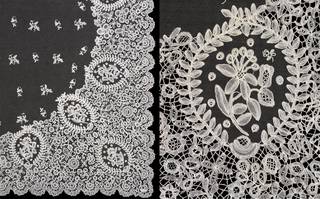Queen Victoria is commonly credited with the wide-scale popularity of the white wedding dress, but how did this association come about?
In 1840, on the day of her wedding, Queen Victoria stated she would make her vows as Albert's future wife, and not in her role as the monarch. She chose to wear a white satin court train, bordered with orange blossom – a symbol of virtue and fertility – instead of the crimson velvet robe of state. This romantic gesture, and the notion of the Queen as an adoring and innocent bride, captured public attention.

The visual ideal of the bride clad in pure white spread quickly, largely owing to the rise of print media and newspapers, and their lively descriptions of society weddings. With print media came commercialisation. Fashion plates, adverts, valentine cards and sheet music, all sold the image of the white dress and lace veil as a model of romantic propriety and purity. As a result, if a bride was marrying for the first time, and could afford it, a white wedding dress became the norm.
Queen Victoria's original choice of white was, however, as much about practicality and patriotism, as it was purity. As head of state, with business on her mind, she wanted to support and stimulate Britain's lace industry. Skilled artisans were facing poverty due to the invention of machine textiles, so she chose a large piece of handmade Honiton lace, and white was the best colour to showcase this.

By the mid- 19th century, white and lace were customary for bridal wear. The V&A's collection of wedding dress holds many stunning examples, such as the gown worn by May Primrose for her marriage to Henry Littledale in 1885. The couple then moved to India and, sadly, May died a year later in a riding accident. The wedding dress was never worn by anyone else and remained in the family, totally unaltered. It is an invaluable example of the height of 1880s fashion – a very slender silhouette with elaborate satin and lace skirts, pulled back and draped over a bustle – which was popular for only a short time.

The overall design of the wedding dress is asymmetrical, yet carefully balanced. Judging from the design and size of the bodice and skirt, May Primrose was a young, fashion-conscious woman, so white was an obvious choice.
While the popularity of the white wedding dress persisted through the 20th century, its symbolism has perhaps now, for contemporary brides, changed again. In an age of accessible fashion, abundant choice and social freedoms, when a modern bride chooses white, arguably she is aspiring to a resonating cultural image, rather than espousing the specific virtues of purity and innocence.
Find out more about wedding dress colour


